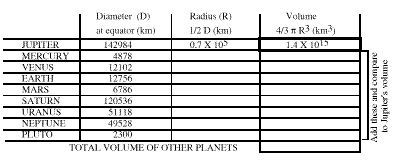
 The volume calculation exercise can be led by the teacher (see the answer key.
The volume calculation exercise can be led by the teacher (see the answer key. The volume calculation exercise can be cut out and done by the students, too.
The volume calculation exercise can be cut out and done by the students, too. In order to fully enjoy this adventure you should learn a few
things about the King of Planets. For one, it's HUGE...
Could all the planets in our solar system fit INSIDE Jupiter?
In order to fully enjoy this adventure you should learn a few
things about the King of Planets. For one, it's HUGE...
Could all the planets in our solar system fit INSIDE Jupiter?

A pretty accurate way to do this is by using scientific notation and rounding to 2 significant digits. For example, Jupiter's diameter can be rounded to 1.4 X 105 km. Half of that is 0.7 X 105 km, Jupiter's radius. You can calculate R3 by multiplying 0.7 X 0.7 X 0.7 (= 0.34) and multiplying the exponent by 3 (5 X 3 =15).... R3 = 0.34 X 1015 km3 . The term (4/3 pi) can be simplified to 4 since pi is about 3 (4/3 X 3 = 4). Jupiter's estimated volume is 1.4 X 10 15 km3 (4 X 0.34 X 1015 ). Without the short-cuts the answer you get is 1.5247 X 10 15 km3.
 A fun way to teach about shapes and volumes is to use modeling clay. Make a sphere for each planet at a manageable size (for example 1 mm per 1000 km of diameter). First
compare the volumes as spheres. Would they fit inside Jupiter "as is"? Then "mash" the
non-Jupiter spheres together into a ball and compare with Jupiter.
A fun way to teach about shapes and volumes is to use modeling clay. Make a sphere for each planet at a manageable size (for example 1 mm per 1000 km of diameter). First
compare the volumes as spheres. Would they fit inside Jupiter "as is"? Then "mash" the
non-Jupiter spheres together into a ball and compare with Jupiter.Using this technique the Jupiter sphere will be 14.3 cm in diameter, and the Pluto sphere will be 2.3 mm in diameter.